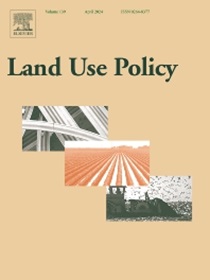Place characteristics that determine citizens’ nature experiences in urban open spaces
IF 5.9
1区 社会学
Q1 ENVIRONMENTAL STUDIES
引用次数: 0
Abstract
Urban open spaces (UOS) as everyday accessible environments are important for citizens’ nature experiences. Rich perceptions of nature reflected in emotions may facilitate a positive human–nature interaction. However, current survey methods do not capture citizens’ emotional nature perceptions. Humans’ emotional perceptions can be captured through arts-based methods such as storytelling but that has not been empirically tested in UOS. In addition, the characteristics of UOS that contribute to such perceptions are unknown. The aim was to explore citizens’ place-inspired perceptions to identify the characteristics that build positive experiences of urban nature. Therefore, UOS characteristics contributing to nature experiences were identified through citizens’ place-inspired stories. We applied digitally enabled spontaneous self-articulated in situ storytelling (DESIS storytelling) at 100 benches located in places with diverse characteristics in Espoo city in the capital region of Finland. We sampled all the 2368 digital clips of stories reflecting perceptions of the100 places. We also performed field observations about the characteristics of 22 places representative of the physical diversity and half of the clips of stories to examine the extent to which citizens’ perceptions of the places depended on the physical characteristics. The results indicated that the arts-based method of DESIS storytelling enables the capture of emotional nature experiences that acknowledge place-based characteristics, contributing to a stronger human–nature connection. Physical characteristics such as scenic views and sheltered environments tended to enrich nature experiences. Mysterious nature elements, in particular, facilitated emotional and embodied perceptions, which playing activities tended to decrease. The findings help to successfully design and manage places that enhance citizens’ connection to nature and encourage a more sustainable urban future.
城市开放空间的场所特征决定了市民的自然体验
城市开放空间(UOS)作为日常可达的环境对市民的自然体验非常重要。对自然丰富的感知反映在情绪中,可以促进积极的人与自然的互动。然而,目前的调查方法并没有捕捉到公民的情感本质感知。人类的情感感知可以通过讲故事等基于艺术的方法来捕捉,但这还没有在UOS中得到实证检验。此外,造成这种看法的不明飞行物的特征是未知的。设计的目的是探索市民对场所的感知,以确定建立城市自然积极体验的特征。因此,通过公民的地方灵感故事,确定了有助于自然体验的UOS特征。我们在芬兰首都地区埃斯波市的100个长椅上应用了数字化的自发自发的原地叙事(DESIS叙事)。我们对所有2368个反映100个地方看法的故事的数字片段进行了抽样。我们还对22个具有自然多样性代表性的地方和一半的故事片段进行了实地观察,以检验公民对这些地方的看法在多大程度上取决于自然特征。结果表明,基于艺术的DESIS叙事方法能够捕捉到基于地点的情感自然体验,有助于加强人与自然的联系。自然景观和庇护环境等物理特征往往丰富了自然体验。特别是神秘的自然元素,促进了情感和具体化的感知,而这是游戏活动倾向于减少的。研究结果有助于成功地设计和管理场所,增强市民与自然的联系,并鼓励更可持续的城市未来。
本文章由计算机程序翻译,如有差异,请以英文原文为准。
求助全文
约1分钟内获得全文
求助全文
来源期刊

Land Use Policy
ENVIRONMENTAL STUDIES-
CiteScore
13.70
自引率
8.50%
发文量
553
期刊介绍:
Land Use Policy is an international and interdisciplinary journal concerned with the social, economic, political, legal, physical and planning aspects of urban and rural land use.
Land Use Policy examines issues in geography, agriculture, forestry, irrigation, environmental conservation, housing, urban development and transport in both developed and developing countries through major refereed articles and shorter viewpoint pieces.
 求助内容:
求助内容: 应助结果提醒方式:
应助结果提醒方式:


